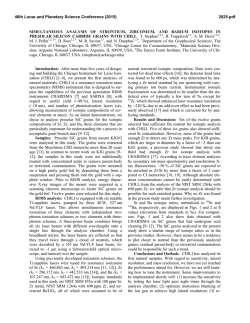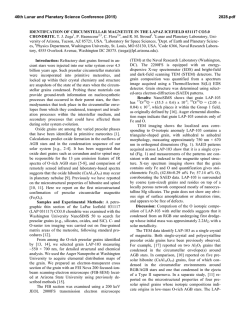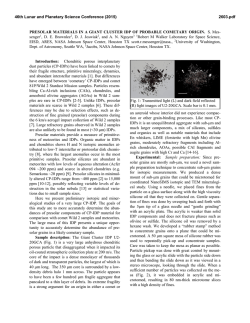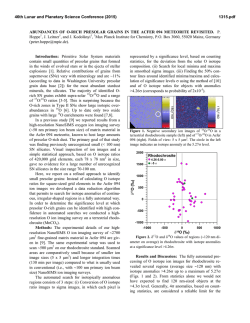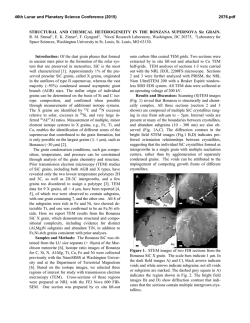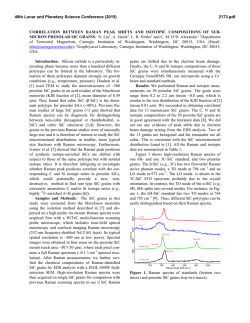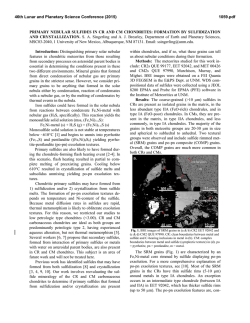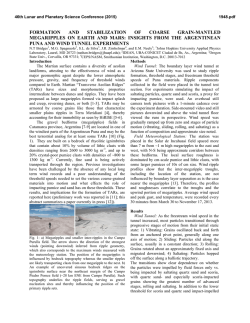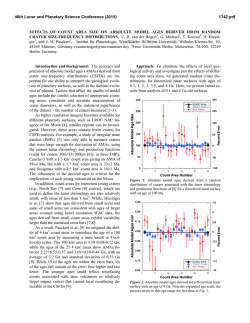
NEW INTERSTELLAR HELIUM AND NEON EXPOSURE AGES OF
46th Lunar and Planetary Science Conference (2015) 1748.pdf NEW INTERSTELLAR HELIUM AND NEON EXPOSURE AGES OF PRESOLAR JUMBO SIC GRAINS FROM MURCHISON. P. R. Heck1,2, F. Gyngard3, C. Maden4, H. Busemann4, R. Wieler4, J. N. Avila5,6, 1Robert A. Pritzker Center for Meteoritics and Polar Studies, The Field Museum of Natural History, Chicago IL, USA. 2 Chicago Center for Cosmochemistry, The University of Chicago, Chicago IL, USA. 3Laboratory for Space Sciences and Department of Physics, Washington University, St. Louis, MO, USA, 4Institute of Geochemistry and Petrology, ETH Zurich, Zurich, Switzerland. 5Research School of Earth Sciences, 6Planetary Science Institute, The Australian National University, Canberra ACT, Australia. E-Mail: [email protected]. Introduction: Interstellar cosmic ray exposure ages of large “Jumbo” presolar SiC grains were determined recently based on cosmogenic Li [1,2] and He and Ne [3]. These are presolar ages relative to the start of the Solar System (t0=4.568 Ga [4]) and are essential to better understand the lifecycle of presolar dust, from dust formation in stellar outflows, residence in the interstellar medium, up to dust incorporation into early Solar System objects. While the SiC samples for both the above mentioned Li and the He, Ne studies were from the same acid residue – the L series from the Murchison CM2 meteorite [5] – the Li ages were determined for a different set of grains than the He and Ne ages, not allowing a direct comparison of results from the different methods. The previous studies have shown that presolar He and Ne ages of 17 grains are below 300 Ma with only three grains having ages of ~400 Ma to ~1 Ga before t0 [3]. Though most presolar Li ages have a similar range as the He and Ne ages from a few dozen Ma to about 1 Ga [1,2], the Li age distribution is not skewed towards young ages as for He and Ne. There are three grains with extremely high Li ages between 2 and 4 Ga before t0 [2], difficult to reconcile with predictions from models of interstellar dust lifetimes [6,7]. Here, we present new He- and Ne-based interstellar CRE ages of “Jumbo” presolar SiC grains whose Libased ages have been previously determined in [2]. Samples and Methods: Seven large presolar mainstream SiC grains with mean diameters of ~5 µm to 14 µm were selected from the Murchison L-series [5]. The grains had been pressed into a gold foil on a mount (“L3”) and previously analyzed by SIMS for Li, B [2], C, N, and Si isotopes as well as for isotopes of several heavy elements [8-11]. Grain volumes were estimated based on two-dimensional SEM images (e.g., [3]) taken before and after SIMS analyses. Such large SiC grains are extremely rare (<10 ppm of the SiC population from Murchison [5]). The more abundant smaller presolar SiC grains are not suitable for exposure age dating because their small sizes result in excessive recoil loss of He, Li, and Ne [12]. Noble gases were extracted with an Nd-YAG IRlaser and He and Ne isotopes were measured with an ultra-high-sensitivity noble gas mass spectrometer [13] at ETH Zurich. Analytical protocols were similar to those employed by [3], with ages calculated based on the cosmogenic 21Ne and 3He concentrations determined here and the interstellar production rates from [14]. In the large presolar SiC grains, the interstellar cosmogenic Ne component is one of three dominant noble gas components, with terrestrial atmosphere (air) and nucleosynthetic He-shell Ne (Ne-G) being the other two. Thus, a three-component deconvolution is sufficient to determine the fraction of cosmogenic Ne. Fig. 1. Presolar Ne (T21), He (T3) and Li (T6) ages of the same presolar SiC grains. T3 and T21 (this study) are corrected for recoil loss and shown with 1σ error bars, which are dominated by counting statistics. Upper limits are indicated by lines connecting the ages downwards to the axis. T6 are from [3] and not recoil corrected. They have nominal analytical errors of 50%. The measured 3He amount in all grains can be considered to be purely cosmogenic in origin because the other components can be neglected [3]. A correction for cosmogenic Ne and He production in SiC during the ~1 Ma [15] exposure of the Murchison meteoroid is negligible for presolar CRE ages >> 1 Ma. Recoil losses for cosmogenic 3He and 21Ne were corrected as described in [12]. The overall uncertainties in the He 46th Lunar and Planetary Science Conference (2015) and Ne exposure ages (not shown in the figures and text) include systematic uncertainties in air corrections, grain volumes, recoil corrections, and in the presolar, interstellar cosmic-ray fluxes and spectra, resulting in a an overall uncertainty of possibly a factor of ~2.8 [3], similar to those estimated for the Li exposure ages [1]. Although presolar exposure ages have large uncertainties, these ages are currently the best estimates of the lifetimes of presolar grains and represent the oldest ages of solid matter dated in the laboratory. Results and Discussion: For five of the measured seven grains we obtained presolar He ages (T3) and for two of them (L3_17 and L3_18) we also obtained presolar Ne ages (T21) – see Fig. 1. For the remaining ages we could only determine upper limits for their concentrations of cosmogenic 3He and 21Ne assuming that all gas is cosmogenic. This results in upper limits for T21 for five grains ranging from 5 to 558 Ma, and for T3 for two grains ranging from 10 to 24 Ma. The two Ne ages of L3_17 and L3_18 agree remarkably well with the He ages (T21=90±16 Ma and T3=82±21 Ma; T21=12±2 Ma and T3=11±3 Ma, respectively), thereby illustrating the self-consistency of our analytical approach. Neon and He ages, or their upper limits, of grains L3_21 and L3_18 match (~12 Ma). Furthermore, their C and Si isotope ratios are identical within errors [8-11]; making it possible that the grains migrated from the same stellar source. Puzzlingly, their T6 ages are much higher (659±330 Ma, 84±42 Ma, respectively). Figure 1 shows that not only do T3 and T21 for grains L3_17 and L3_18 match within uncertainties, but also for the other three grains with T3 and only upper limits for T21 determined, an agreement between T3 and T21 is not ruled out. This confirms that the production rate ratios for cosmogenic He and Ne and the recoil corrections are reasonable and that the determination of the cosmogenic He and Ne components is reliable. Furthermore, it excludes major diffusive loss of He and Ne, otherwise, preferential depletion of He relative to Ne would have been observed. The new He and Ne ages and the upper limits show a similar distribution as previously determined ages, as seen in Fig. 2, with the majority of the grains having ages <300 Ma before t0. It was hypothesized by [3] that this pattern could be the result of a starburst event a few billion years prior to the formation of the Solar System [16]. Parent AGB stars formed in this starburst may have led to a concurrent production of SiC dust at the C-rich end of their lives, which could have resulted in an overabundance of grains with a similar age range, as reflected by the age peak at <300 Ma (Fig. 2). Although the Li age [3] of L3_17 agrees with T3 and T21 within uncertainties, this Li age and the other 1748.pdf Li ages in [3] are not corrected for recoil loss. The Li age of L3_18 is a factor of 7-8 higher than T3 and T21. The T6 of other four grains are factors of 2 to 92 higher than the T21 and T3 values or their upper limits. The grains (L3_14 and L3_05) with extreme T6 of 2.2±1.1 Ga and 4.2±2.1 Ga, however, have T21 upper limits of only 349 Ma and 558 Ma, and T3 values of 39±27 Ma and 276±237 Ma, respectively (Fig. 1). Recoil corrected T6 values would only make the discrepancies worse. It is currently unclear why the Li ages are so different from to the He and Ne ages. More correlated He/Ne and Li ages need to be determined in order to investigate this discrepancy, in addition to updated production rate calculations and recoil corrections. Fig. 2. Distribution of all known Ne (T21), He (T3), and Li (T6) presolar ages of presolar SiC grains. The grains with T6 > 1 Ga are not shown here. T21 and T3 from this study (dark red and blue solid) and [3]; T6 from [1,2]. References: [1] Gyngard, F. et al. (2009) Astrophys. J., 694, 359. [2] Gyngard, F. et al. (2014) LPS XLV, Abstract #2348. [3] Heck, P. R. et al. (2009) Astrophys. J., 698, 1155. [4] Bouvier, A. & Wadhwa, M. Nature Geosci., 3, 637–641. [5] Amari, S. et al. (1994) Geochim. Cosmochim. Acta, 58, 459–470. [6] Jones, A. P. et al. (1997), in AIP Conf. Proc. 402, ed. T. J. Bernatowicz & E. Zinner (Melville, NY: AIP), 595. [7] Jones, A. P. & Nuth III, J. A. 2011 A&A 530, A44. [8] Avila, J. N., Ph.D. Thesis, ANU. [9] Avila, J. N. et al. (2012) Astrophys. J., 7449, 49. [10] Avila, J. N. et al. (2013) Geochim. Cosmochim. Acta, 120, 628–648 [11]. Avila, J. N. et al. (2013) Astrophys. J., 768, L18. [12] Ott, U. et al. (2009) PASA, 26, 297– 302. [13] Baur, H. (1999) EOS Trans. AGU, 46, F1118. [14] Reedy, R. C. (1989) LPS XX, Abstract #888. [15] Roth, A. S. G. et al. (2011) Meteorit. Planet. Sci., 46, 989–1006 [16] Clayton, D. D. (2003) Astrophys. J., 598, 313.
© Copyright 2026
